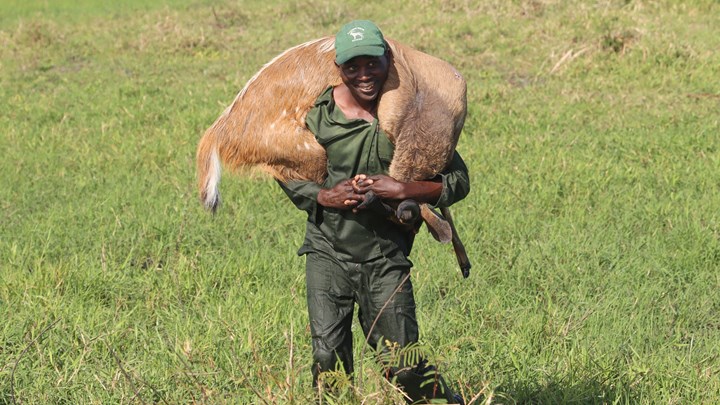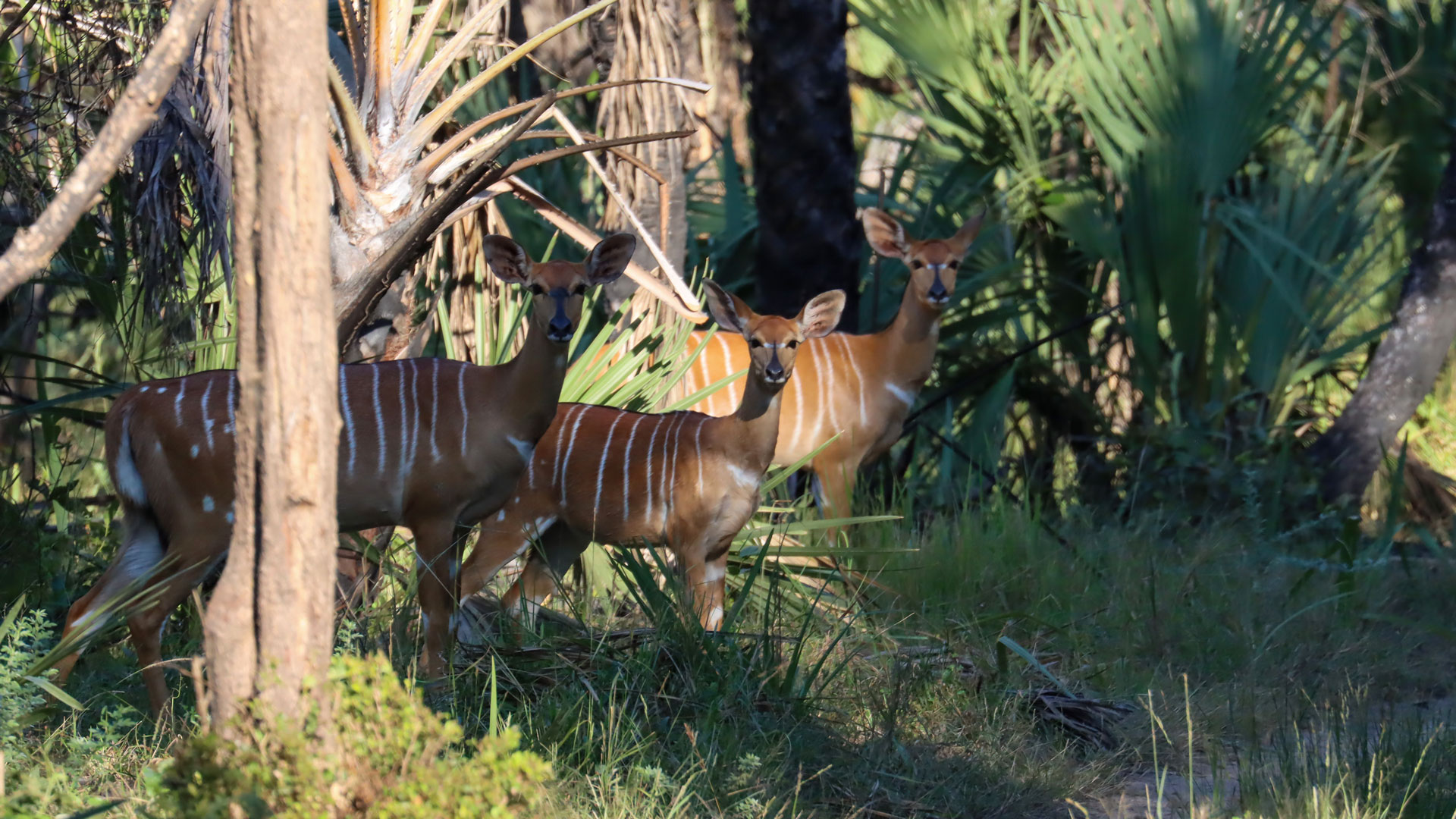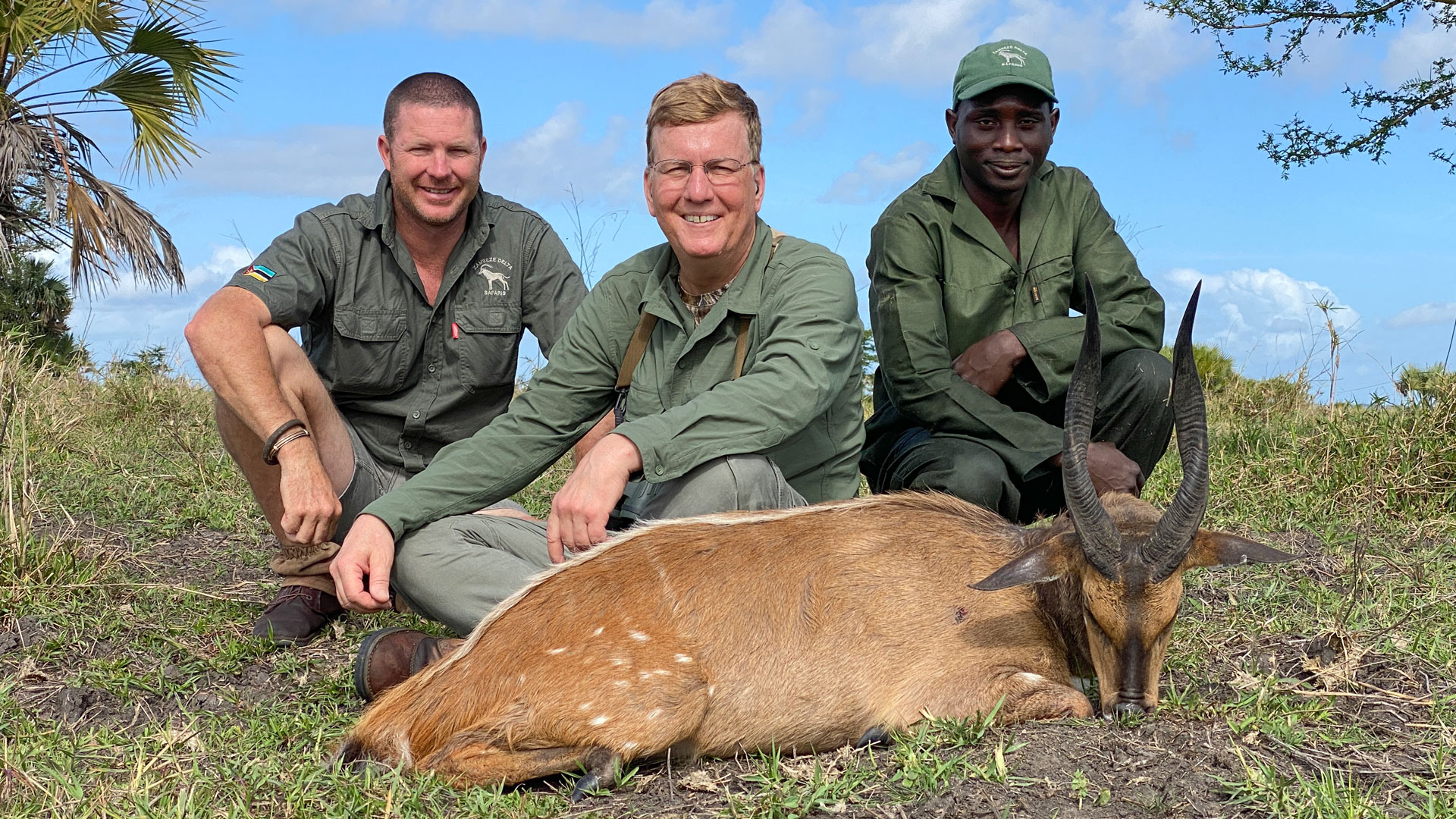
by Mike Arnold - Thursday, April 20, 2023

We had not seen any suitable bushbuck rams. “Suitable” would have been an older male with spiraled horns measuring 14 inches, or maybe a bit more. We might have seen one ram who made the grade, spotted right at the end of the crepuscular period one evening as we headed back towards camp for a shower, dinner and a sundowner near the comforting firepit. But, as the Land Cruiser shuddered to a halt, he gave a single bark, turned on his heals and launched himself into the dense Miombo Forest. Professional hunter (PH) Dylan Holmes and tracker Albiño weren’t certain of age and size from the short glimpse into the gloom. But, of course, either way, I had no chance for a shot.
The pursuit of the beautifully spotted, light-ochre-colored, Chobe bushbuck was taking place in the confines of Coutada 11, the world-class hunting concession run by Zambeze Delta Safaris. I was on the second of two safaris into this paradise of wildlife, birdlife, plant life and more. And I had yet to encounter the mature bushbuck of my dreams. That is not to say that I wasn’t seeing bushbucks. There was even an obviously pregnant ewe who browsed slowly each day on a termite mound just outside the tent where my wife, Frances, and I slept. But compared with their cousins, the nyalas, only rare meetings characterized the Chobe bushbucks.
In fact, it is likely that the large populations of the elegant nyalas in Coutada 11 were a contributor to the limited numbers of their smaller relatives. To put it into the words of scientists studying interactions between these species in South African preserves: A very real overpopulation problem is occurring in the Ndumu Game Reserve in KwaZulu-Natal, South Africa, where one species of antelope, the nyala, is crowding out another species, the bushbuck. Like Rocky Mountain elk versus mule deer, the larger and more prolific nyalas appear capable of pushing bushbucks from prime feeding, birthing and resting areas. Both of my PHs on my two safaris were concerned about nyala overpopulation in this area. Regardless of the cause, PH Dylan and tracker Albiño were finding it tough to find a mature bushbuck ram.

The last day of the hunt dawned bright and clear, with a shower during the night having scrubbed away the haze from the smoke and ashes of the frequent fires set by the PHs and staff—fires intended to protect habitat by burning the grass that often towered 7 feet tall in the now-dry pans and in the glades in between woodlands. Today we would see Dylan and Albiño’s last play and, as explained by my PH, it was a “Hail Mary” of an option.
“Since we have not found the bushbucks where we normally do, we are going to head out to where we rarely, if ever, see them—the open fever-tree forests at the edge of the floodplain.” Though I didn’t think this would work, I was happy to head back to one of my favorite areas in the concession. I loved the mix of starkly white and green fever trees with the stately lala palms and brushy palmettos in the woodlands bordering the open floodplains.
As we slowly entered the woodland area, a pair of beautiful saddle-billed storks looked up from their fishing expedition as they waded through a shallow pond. Brilliant white feathers framed larger areas of black plumage covering their wings and long necks. The storks’ knees appeared swollen because of their brilliant red coloration, the same color reflecting from their feet when lifted above the water. Both genders possessed the source of their common name—a yellow, raised plate beginning just below the crown of their heads, extending down the top of their bills, which looked remarkably like a tiny English saddle. To complete the effect, the male’s yellow wattles took on the form of stirrups dangling from his yellow saddle.
Dylan slowly rounded another island of vegetation consisting mostly of a broad stand of palmettos with a lala palm growing from the exact center when a quiet tap sounded on top of the Land Cruiser’s cab. Albiño had spotted an animal 500-plus yards in the distance. I had no idea what I was looking at until I brought my Vortex rangefinder-binocular to my eyes. Even with the optics, the animal’s shape and color blended with the brown-green-white background. Fortunately, my PH and tracker could tell that this animal was what they hoped to find: an old and impressive bushbuck ram.
“If we can get you in shooting range, that’s your ram,” Dylan said. Just then, the ram entered an unseen tributary, submerging except for the top of his head, horns and nose. Had he spotted us? Heard us? Swimming quickly, he crossed the 50-yard-wide stream and climbed onto a small island. Instead of hurrying on as a frightened animal would, he began browsing leaves from the scattered bushes and small trees. We quickly unloaded from the Land Cruiser, Albiño taking only a moment to hand me the .300 Winchester Magnum camp rifle and shooting rest. Walking single file with Albiño taking the lead followed by Dylan, then me and finally my photographer/videographer wife, Frances, our guides kept the scattered palmetto stands, fever trees and assorted bushes between us and the island where the ram was located.
With unerring instinct, Albiño led us at an angle, seeming to head away from the ram’s position but reducing the distance with each step. When we finally reached the deep waterway, we were about 100 yards away in a natural palmetto hide. Dylan took one final look through his optics and opened the rest. Laying the rifle slowly into the two rest points to secure the butt and fore-end, the .300 Win. Mag. was rock solid. Just as the crosshairs steadied on the ram’s shoulder, I realized that he was preparing to lie down for a late-morning rest. His knees bent just as the trigger broke. He dropped without a twitch.
Albiño wasted no time crossing over to where the ram lay, quickly pulling off his shoes, socks and belt and emptying his pockets of items that would not withstand a dunking. I asked to go with him to help bring back the bushbuck. This led to a huge smile from him and a few words in rapid-fire Fanagalo—that unique mixed-language consisting of English, Afrikaans and Portuguese with some of the local Sena dialect thrown in for good measure—between PH and tracker. Dylan turned to me with a smirk and said, “Albiño says that the only thing that will happen if you go with him to get the ram is that he will have to carry both of you back.” I assumed Albiño knew what he was talking about and had made a wise assumption.
I watched as Albiño began his traverse, the water going from ankle- to knee- to chest-deep within a few feet of the edge of the streambed. Upon reaching the ram, he quickly hoisted the heavy, limp form onto his shoulders, wrapping the legs around his chest as an anchor hold for the trek back. I worried the extra weight might force him into the muddy bottom and submerge him, but he used his bare feet to find firmer ground by feel. Even so, by the time he made it back to our side of the waterway, Albiño was soaked from his neck down.

The ram was one of the most amazing animals I’d ever seen, and one of the oldest animals I’d ever taken. He was so old that his spine jutted several inches above his back, with no fat and little muscle running along the ridge. His neck was bald, his forehead rubbed clean of hair, his ears torn, hairless and smooth as tanned leather, and his teeth worn to stubs. “Would not have made it through another year,” was Dylan’s comment. A perfect animal to take, I thought. Found in a most unlikely spot, the ram had chosen to spend his remaining days away from the competitive nyalas, and out of the way of PHs and their clients. Dylan and Albiño had thrown a Hail Mary, choosing to search this spot for a species normally attracted to other habitats.
Looking at the worn but massive, horns I wondered out loud about their length. Dylan and Albiño again went into their Fanagalo. They were placing a bet. Later we would find that each horn measured 17 inches around the curve with bases exceeding 6½ inches.
An outstanding, mature animal was the best description of my Chobe bushbuck. But it wasn’t really the length of his horns that captivated me. It was his age denoted by his battle-scarred hide, his worn-down teeth and his leathery ears and forehead. An old champion—and the reason I hunt. I live to harvest beautiful, mature males past their prime and likely with numerous offspring to take their place. This bushbuck was ours because of the skill of my PH and tracker friends and, of course, a healthy measure of luck.
About the Author
Mike Arnold is a professor of Genetics at the University of Georgia and author of the 2022 book Bringing Back the Lions: International Hunters, Local Tribespeople and the Miraculous Rescue of a Doomed Ecosystem in Mozambique. Mike’s book is available for purchase by clicking here.
E-mail your comments/questions about this site to:
[email protected]
